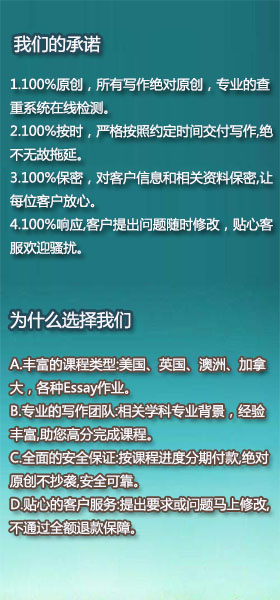本文是美国代考、留学生代写exam代考、论文代写范文:薪酬管理和期望的工作成果,主要内容是通过薪酬管理的研究,分析如何激励员工更加努力工作,保留现有员工,吸引新员工,提高工作满意度和承诺。
铭信拥有哈佛、耶鲁、牛津、剑桥等世界各大名校的众多博士、硕士,及国际著名专家,涵盖“文、理、工、商、艺”五大学科,60门热门专业,超过240种不同科目的标准化课程教研体系。您的订单经过严格校对,turnitin检查确保您一次性通过。即使作品完成了您还是可以申请免费的修改或turnitin报告。
在当今竞争激烈的商业环境中,企业正在寻找改善业务成果的方法。员工是获得竞争优势的源泉之一。因此,公司已经开始投资于人力资源,以解锁员工的潜力,从而取得更好的结果。这已成为奖励管理的发展,作为一种工具,以达到预期的工作成果。
人力资源管理有许多工具可用于管理员工的行为。其中一个工具就是奖励管理。在组织中实施奖励管理可以改善企业业绩和员工行为和贡献的积极转变。为了确保组织的成功,企业应该找到一个适当的组合回报,满足个人和财务需求的现有的和潜在的劳动力给现有的商业条件和成本的限制(WorldatWork,p.xx)。因此,管理层开始使用奖励管理来激励员工更加努力工作,保留现有员工,吸引新员工,提高工作满意度和承诺,以达到预期的业务结果。
In today's competitive business environment,businesses are looking for ways to improve their business results.Employees are one source to achieve competitive advantage.Thus,companies have started to invest in the human resource to unlock employee potential thereby achieving better results.This has given rise to the development of reward management as a tool to achieved desired job outcomes.
The human resource management has many tools that can be applied to manage employee's behaviours.One of the tools is reward management.Applying reward management in organisations can improved business results and a positive shift in employees behaviour and contributions.In order to ensure organizational success,businesses should find a proper mix of rewards that satisfies the personal and financial needs of a current and potential workforce given existing business conditions and cost constraints(WorldatWork,p.XX).Thus,management started to use reward management to motivate employees to work harder,to retain its existing employees,to attract new employees,to increase job satisfaction and commitment to achieve desired business results.
The diagram below shows how the total reward strategy in a company can influence motivation,attraction,retention,satisfaction,engagement and performance and results.
The WorldatWork introduce a total reward framework that will help practitioners think and execute in new ways(WorldatWork 2007)."WorldatWork defines total rewards as the monetary and non-monetary return provided to employees in exchange for their time,talents,efforts and results"(WorldatWork 2007,p.4).It involves the deliberate integration of the five key reward elements:compensation,benefits,work-life,performance and recognition,developments and career opportunities that effectively attract,motivate and retain the talent required to achieve desired business results(WorldatWork 2007).





